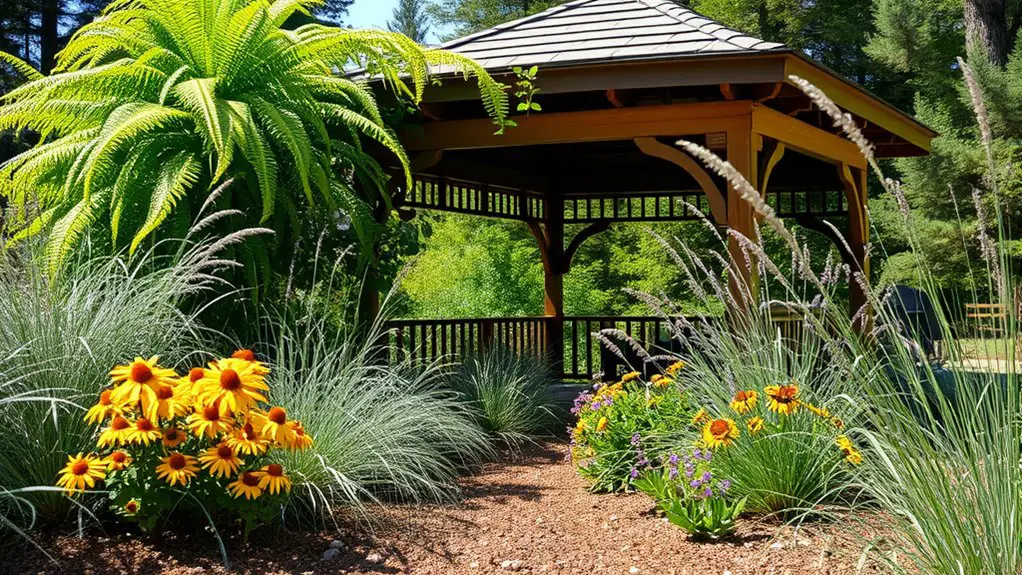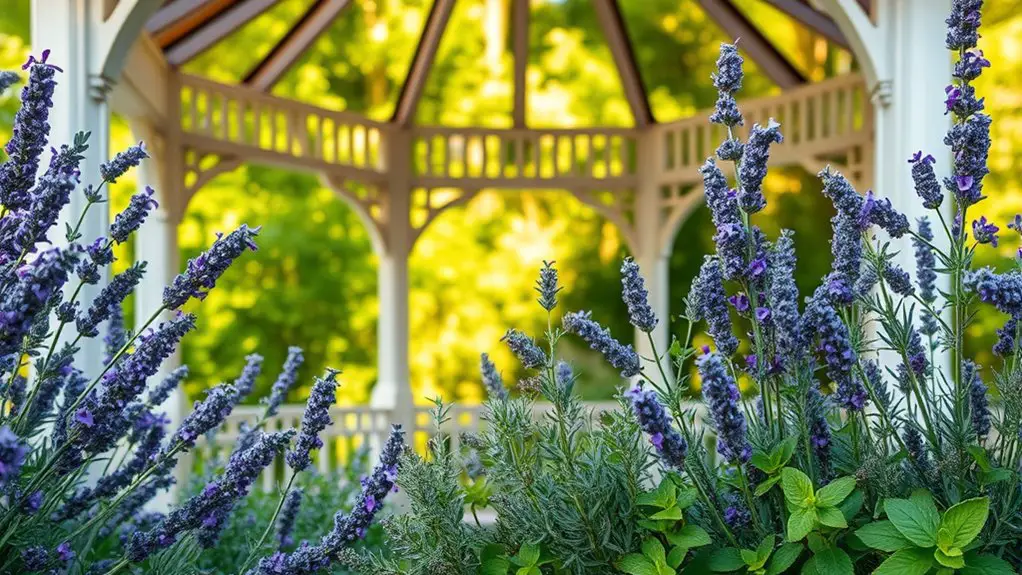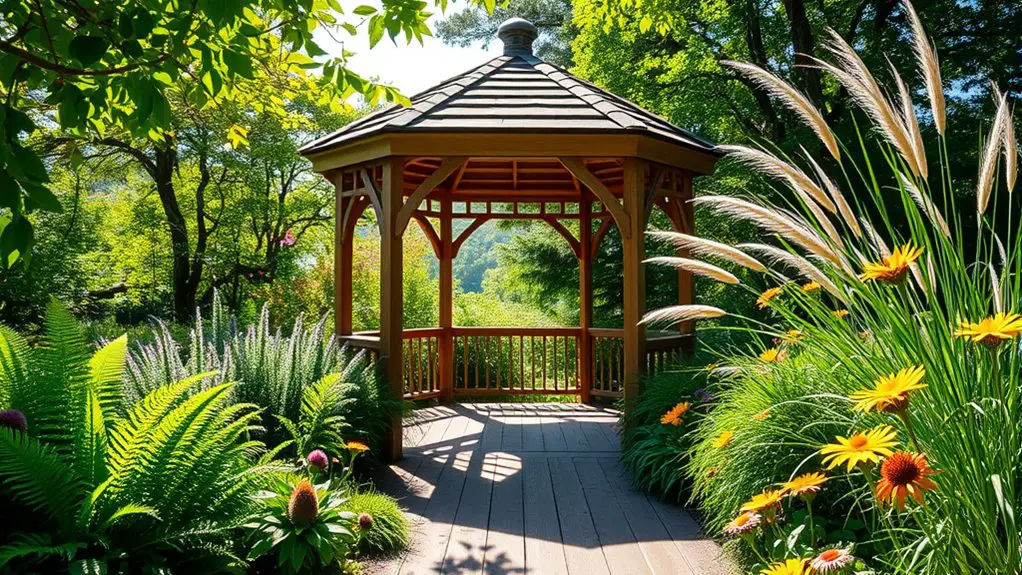To create a beautiful and sustainable space around your gazebo, consider native plants like vibrant coneflowers and black-eyed Susans for color, alongside drought-resistant lavender and hardy ground covers to minimize maintenance. Additionally, shade-loving ferns and woodland wildflowers can add lush greenery in darker areas, while native grasses introduce movement and sound. By carefully planning your layout and plant selection, you’ll enhance both the aesthetics and ecology of your outdoor retreat. There’s so much more to explore!
Understanding Native Plants and Their Benefits

When you choose native plants for your gazebo, you’re not just enhancing your outdoor space; you’re also fostering a connection to the local ecosystem. Native plants thrive in their specific environments, requiring less water and maintenance than exotic species. By incorporating them, you’re supporting native plant ecosystems that provide essential habitats for local wildlife—think butterflies, bees, and birds. These plants form intricate relationships with the soil and surrounding organisms, promoting biodiversity and ecological benefits.
Moreover, native plants help prevent soil erosion and filter pollutants, contributing to a healthier environment. You’ll find yourself not only enjoying the beauty they bring but also participating in a larger movement toward ecological balance. Imagine sipping tea on your gazebo, surrounded by plants that are alive with activity and color, knowing you’ve made a choice that enriches both your life and the world around you. Embrace the freedom to cultivate beauty while nurturing nature!
Vibrant Flowering Plants for Colorful Accents
If you want your gazebo to burst with color, choosing seasonal blooms is a fantastic way to make a statement. Not only will these vibrant plants attract pollinators, enhancing your garden’s ecosystem, but many options are also low maintenance, allowing you to enjoy their beauty with minimal effort. Let’s explore some perfect flowering plants that can add a lively touch to your outdoor oasis.
Seasonal Blooms for Impact
Choosing the right seasonal blooms can transform your gazebo into a vibrant oasis, bursting with color and life throughout the year. By selecting native plants with varying bloom timings, you’ll guarantee a continuous display of seasonal color that captivates the eye. In spring, consider adding native columbine or wild geraniums for a fresh pop of color. As summer rolls in, vibrant coneflowers and black-eyed Susans will thrive, creating a lively atmosphere. Shifting to autumn, goldenrods and asters will extend the beauty well into the cooler months. Finally, integrate winter-friendly shrubs like winterberry to maintain visual interest. Embrace the freedom of nature’s palette, and let these seasonal blooms create a stunning backdrop to your gazebo retreat.
Attracting Pollinators Naturally
To create a lively ecosystem around your gazebo, consider incorporating vibrant flowering plants that not only enhance visual appeal but also attract essential pollinators. Opt for native species like coneflowers, black-eyed Susans, and milkweed, which thrive in your region and provide excellent pollinator habitats. These plants are native bee friendly, offering a reliable food source for bees, butterflies, and other beneficial insects. By choosing a diverse array of colors and bloom times, you’ll create a stunning backdrop while fostering a natural environment. Imagine the joy of watching pollinators flit about, all while you enjoy your serene outdoor space. Embrace the beauty of nature and create a sanctuary that buzzes with life around your gazebo!
Low Maintenance Options Available
While attracting pollinators is a fantastic way to enhance your gazebo’s surroundings, you might also want to contemplate plants that require minimal upkeep but still deliver vibrant blooms. Consider easy care shrubs like the native butterfly bush, which thrives with little attention and offers stunning clusters of flowers. You’ll love how resilient perennials, such as coneflowers and black-eyed Susans, pop with color and attract butterflies while needing only occasional watering. Pair these with ornamental grasses for texture, creating an effortless yet beautiful landscape. With these low maintenance options, you can enjoy a lively garden that complements your gazebo without the fuss. Embrace the freedom of nature’s beauty without the burden of constant care!
Lush Green Foliage Plants for Texture and Depth
As you cultivate your gazebo oasis, incorporating lush green foliage plants can transform the space into a serene retreat. Think of plants like ferns, hostas, and native grasses that add layers of texture and depth. These lush foliage options not only create visual interest but also provide a calming backdrop to your outdoor haven.
Consider plant combinations that thrive together, such as the feathery fronds of maidenhair fern paired with the broad leaves of a hosta. This mix not only enhances the aesthetics but also fosters a micro-ecosystem that attracts beneficial wildlife.
Using varying heights and shades of green can establish a sense of movement and life around your gazebo. Allow these plants to weave a tapestry of tranquility, inviting you to relax and embrace the freedom of nature. Your gazebo will feel like a lush escape, perfectly suited for unwinding or entertaining friends.
Fragrant Herbs to Enhance the Outdoor Experience

What could be more delightful than the invigorating scents of fragrant herbs wafting through your gazebo? Surrounding your outdoor retreat with aromatic foliage not only enhances the ambiance but also adds a touch of culinary charm. Imagine the joy of picking fresh herbs right at your fingertips. Here are some excellent options to ponder:
- Basil: This culinary herb brings a sweet, peppery aroma that complements summer gatherings.
- Lavender: Known for its calming scent, lavender can transform your space into a serene escape.
- Rosemary: With its pine-like fragrance, rosemary offers a robust scent that invigorates the senses.
Planting these herbs not only beautifies your gazebo but also invites an essence of freedom and creativity into your outdoor experience. Let the scents inspire your culinary adventures and elevate your relaxation time, creating a delightful environment you’ll cherish.
Attracting Pollinators With Native Flora
Enhancing your gazebo with fragrant herbs not only caters to your senses but also creates an inviting habitat for beneficial pollinators. By incorporating native flora, you can establish vibrant pollinator pathways that connect your garden to the larger ecosystem. Consider planting seasonal bloomers like coneflowers and bee balm, which provide essential nectar and pollen throughout the growing season.
These plants not only attract bees, butterflies, and hummingbirds but also add a splash of color and a delightful aroma to your outdoor space. To maximize your impact, group your plants in clusters to create a more enticing environment for these crucial creatures. Remember, the more diverse your native flora, the more pollinators you’ll attract! By nurturing a dynamic ecosystem around your gazebo, you’re not just beautifying your space; you’re actively supporting nature’s incredible cycle. Embrace the freedom of gardening that welcomes life!
Ground Covers to Prevent Weeds and Erosion

When you’re designing your gazebo’s landscape, consider using ground covers that not only enhance beauty but also combat weeds and prevent soil erosion. These hardy plants create a lush carpet that protects your garden while requiring minimal maintenance. Let’s explore some top native options that can thrive in your space and provide lasting benefits.
Benefits of Ground Covers
Although many gardeners focus on vibrant flowers and lush shrubs, incorporating ground covers around your gazebo can provide an array of benefits, particularly in preventing weeds and controlling erosion. These resilient plants offer some fantastic ground cover benefits that enhance your landscape while keeping it functional.
- They suppress weed growth, reducing maintenance time.
- Their extensive root systems help stabilize soil and prevent erosion, especially on slopes.
- They create a lush, green carpet that adds visual appeal and biodiversity.
Top Native Options
To create a picturesque and functional landscape around your gazebo, choosing native ground covers can be a game changer. These resilient plants not only enhance beauty but also prevent weeds and erosion. For your plant selection, consider regional varieties like creeping thyme, which adds a touch of color and fragrance, or wild ginger, known for its lush foliage. If you’re in a drier region, prairie dropseed thrives while offering a graceful, airy look. In wetter areas, look to golden groundsel, which provides vibrant blooms and lush coverage. Each of these options works harmoniously with your gazebo, giving you the freedom to enjoy a low-maintenance, eco-friendly retreat. Embrace the beauty of nature and choose wisely!
Drought-Resistant Plants for Low-Maintenance Landscaping
As temperatures rise and water becomes scarcer, incorporating drought-resistant plants into your gazebo’s landscape not only conserves resources but also guarantees a vibrant garden with minimal upkeep. These native adaptations are perfect for those seeking freedom from constant maintenance. Here are some excellent options to evaluate:
- Lavender: Its fragrant blooms draw pollinators while thriving in dry conditions.
- Black-eyed Susan: This cheerful flower adds color and attracts birds, flourishing with little water.
- Agastache: Known for its resilience, it offers stunning spikes of color and aromatic foliage.
Shade-Tolerant Options for Shaded Areas Around the Gazebo
When you’re looking to enhance the shaded areas around your gazebo, selecting shade-tolerant plants can transform those dimly lit spots into lush havens. Consider incorporating shade-loving ferns, like the delicate maidenhair or robust ostrich fern, which add texture and vibrant green hues to your landscape. These ferns thrive in low-light conditions, creating a serene backdrop for your outdoor oasis.
Don’t overlook woodland wildflowers, such as trillium or bluebells, which bring bursts of color and a touch of whimsy to the shaded ground. These native beauties not only flourish in the shade but also attract pollinators, enriching your garden’s ecosystem.
Incorporating Native Grasses for Movement and Sound
Native grasses can add a delightful dimension to your gazebo space, bringing both movement and sound that enhance the overall ambiance. Their ability to sway gently in the breeze creates a enchanting dance, while their rustling leaves introduce a unique sound texture that can soothe your senses. Consider incorporating these native grasses for a vibrant touch:
Enhance your gazebo with native grasses, adding movement and soothing sounds that transform your outdoor ambiance.
- Little Bluestem: Its vertical structure adds height and drama, catching the wind beautifully.
- Prairie Dropseed: This grass emits a soft, sweet sound as it moves, enriching your outdoor experience.
- Sideoats Grama: With its distinctive seed heads, it offers both visual interest and delightful rustling sounds.
Planning Your Planting Layout for Maximum Impact
Creating a thoughtfully designed planting layout can transform your gazebo area into a stunning oasis that feels both inviting and harmonious with nature. To maximize impact, consider your planting zones and aim for design symmetry. This will enhance the visual appeal while ensuring plants thrive in their ideal conditions.
Here’s a simple layout suggestion to get you started:
| Plant Type | Suggested Location |
|---|---|
| Tall Perennials | Back of the Gazebo |
| Medium Shrubs | Sides of the Gazebo |
| Low Groundcovers | Front of the Gazebo |
Frequently Asked Questions
How Do I Choose the Right Native Plants for My Climate?
To choose the right native plants for your climate, consider regional plant diversity and climate adaptation strategies. Look for local flora that flourishes in your area, ensuring vibrant, resilient growth while embracing nature’s beauty.
What Are the Best Times to Plant Native Species?
You’ll want to plant native species in early spring or late summer for ideal growth. These seasons provide the best conditions for roots to establish, ensuring your plants thrive and celebrate nature’s freedom in your garden.
Can Native Plants Attract Pests to My Gazebo?
Yes, native plants can attract pests, but with smart plant selection, you can enhance pest control. Choose species that naturally repel unwanted insects, creating a harmonious balance around your gazebo while enjoying nature’s beauty.
How Long Does It Take for Native Plants to Establish?
Think of native plants as a gentle tide, slowly rolling in. Their establishment period varies, usually taking one to three years, depending on growth rate and conditions. Patience rewards you with a thriving, vibrant landscape.
Are There Any Native Plants That Are Toxic to Pets?
Yes, some native plants can be toxic to pets, so it’s essential you check for pet safety. Always research before planting, ensuring your furry friends stay safe while you enjoy your vibrant, natural landscape.


magnificent points altogether, you just gained a brand new reader. What would you suggest in regards to your post that you made a few days ago? Any positive?